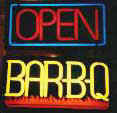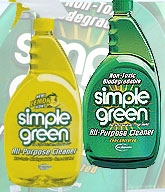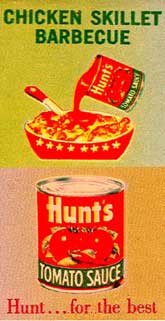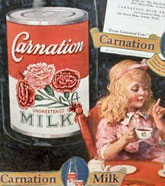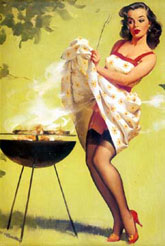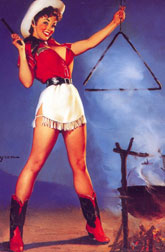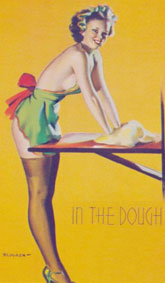Contact BBQbyDan
www.BBQDan.com
Search
KCBS BBQ Cook-Off Info
Recipes,
Smoking Meats
Recipes, Grilling
|
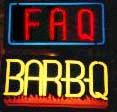 |
FAQ OF THE INTERNET BBQ LIST Version 2.0 Section 18 Making Lump Charcoal |
--------------------
[How can I make my own lump charcoal?]
Belinda M.--
Here is the recipe to make your own lump wood charcoal
To make 30-40 lb. of charcoal, you will need:
1 A clean 55 gallon metal drum with the lid cut off roughly (you will be able to reuse this drum many, many times).
2 Enough seasoned wood to fill said drum, chopped into big fist-size pieces--about 5"x5", and the wood just needs to be a couple months seasoned, although the dryer the wood, the faster the process.
3 A bag of sand.
4 3 or 4 bricks.
5 A case of beer (optional).
Start by punching or cutting 5 holes in the bottom of the drum which are each 2" square. Try to keep them towards the center. Put the drum down on the bricks, placed so it is up off the ground and fill it with the wood.
Start a fire in the drum. When it is going well, put the top back on to reflect back the heat. Since it was cut off roughly, there will be slight gaps to allow a draft.
Now, turn the whole thing over, placing it back onto the bricks. (This is where you might need the case of beer to convince several men to help you lift the sucker. It will be heavy. And mind the lid doesn't fall off!) Wait, consuming the beer as necessary.
The smoke will start out white. This is the water vapor burning off. Next the smoke will go blue/gray which is the alcohols and phenols burning off.
Then the smoke appears yellow, which is the tar burning off. Finally the smoke will clear and you will just see waves of heat. When this happens, carefully remove the bricks from underneath the drum. Take some sand and make a pile around the bottom of the drum, plugging up the bottom draft. Also, cover the top with either a piece of turf or a large piece of metal. Use sand to seal around the turf/metal so no air can get into the drum. We are trying for a closed system here. If air/oxygen/fire-fuel DOES get into the drum, the charcoal will just burn up. Not what we want. Also, try not to let the sand fall down into the drum through the holes.
Allow the drum to sit and cool (2-3 hours). Then turn back over, pry off the top and remove your charcoal. If there is a spark, the charcoal may "catch", but just douse it with some water. The charcoal will still be hot enough to dry out. Repeat above process as necessary.
By the way. I know this should be obvious, but, only use hardwood for your charcoal. By hardwood, I mean any broadleaf tree. Such as maple, almond, ash, alder, hickory, cherry, etc. You can use non-broadleaf wood (such as pines, firs and conifers) for charcoal but that charcoal will never get hot enough when it is burned. Therefore, it is only good for distillation purposes. Which, in itself, might be a handy tip. Also, this creates one heck of a lot of smoke, so don't make charcoal when the neighbor's laundry is outside on the line. (Of course, by now, you all would know that but, just in case there are a few who haven't really done a lot of smoking yet... a word to the wise and all that!)
Thanks to my brother-in-law, Don Whiting, who taught me how to do this.
==============Here is another method for making lump charcoal--
John H Cartlidge--
I've recently been given a book on woodland crafts (1) which contains a very similar method - minus the juggling! As I've not had a chance to try it yet, I've reproduced the method verbatim. There are also a couple of small line drawings in the book illustrating the process.
1 Using a cold chisel prepare the drum by making five 2-inch holes in one end and completely removing the other end. Knock-up the cut edge of the open end to form a ledge(2).
2. Position the drum, open end upwards, on three bricks to allow an air flow to the holes in the base.
3 Place paper, kindling and brown ends (incompletely charred butts from the last burn) into the bottom of the drum and light.
4 Once it is burning well, load branchwood at random to allow air spaces until the drum is completely full. Keep the pieces to a fairly even diameter but put any larger ones to the bottom where they will be subjected to a longer burning.
5 When the fire is hot and will clearly not go out, restrict the air access around the base by using earth placed against it, but leaving one 100mm (4in) gap. Also place the lid on top, leaving a small gap at one side for smoke to exit
6 Dense white smoke will issue during the charring process. When this visibly slows, bang the drum to settle the wood down, creating more white smoke.
7 When the smoke turns from white (mainly water being driven off) to thin blue (charcoal starting to burn) stop the burn by first closing off all air access to the base using more earth, and second by placing the lid firmly on its ledge, and making it airtight by the addition of sods and soil as required. The burn will take between three and four hours.
8 After cooling for about 24 hours, the drum can be tipped over and the charcoal emptied out onto a sheet for grading and packing.
Notes:
(1) Traditional Woodland Crafts. Raymond Tabor. Published by Batsford, London,UK ISBN 0-7134-7138-7
(2) Note, the lid will have to placed back on this ledge and made airtight.
Go to the next section
Return to the Table of Contents
Return to the BBQ FAQ Home Page
Comments or Suggestions
BBQ FAQ Ver 1.0, 2.0 ©1997, 1998 William W. Wight. All rights reserved.

